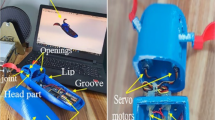Abstract
In this paper, we analyze a propulsive force generated from pectoral fins for a rajiform-type fish robot from fluid dynamic aspects. A pectoral fin of the rajiform-type fish robot is constructed by multiple fin rays, which move independently, and a film of pushing water. Then, the propulsive force of the fish robot is analyzed from the momentum of the fluid surrounding for every fin between fin rays. The total propulsive force for one pectoral fin is the sum of these momenta. The propulsive speed of a fish robot is determined from the difference of the propulsive force generated from pectoral fins, and the resistance force that the fish robot receives from the water when moving forward. The effectiveness of the proposed method is examined through numerical simulation and actual experimental results.






Similar content being viewed by others
References
Yuh J (1994) Learning control for underwater robotic vehicles. IEEE Control Syst Mag 14(2):39–46
Yuh J (2000) Design and control of autonomous underwater robots: a survey. Auton Rob 8(1):7–24
Watanabe K, Izumi K (2008) Skilful control for underactuated robot systems: from the ground to the air and underwater. In: Proceedings of the 2nd international conference on underwater system technology: theory and applications 2008 (USYS ’08), pp 4–5
Watanabe K, Izumi K, Okamura K, Syam R (2008) Discontinuous underactuated control for lateral X4 autonomous underwater vehicles. In: Proceedings of the 2nd international conference on underwater system technology: theory and applications 2008 (USYS ’08), Paper ID 14
Zain ZM, Watanabe K, Izumi K, Nagai I (2013) A discontinuous exponential stabilization law for an underactuated X4-AUV. Artif Life Rob 17(3-4):463–469
Ynag S, Qiu J, Han X (2009) Kinematics modeling and experiments of pectoral oscillation propulsion robotic fish. J Bionic Eng 6:174–179
Zhou C, Low KH (2012) Design and locomotion control of a biomimetic underwater vehicle with fin propulsion. IEEE/ASME Trans Mechatron 17(1):25–35
Seo K, Chung SJ, Slotine JJE (2010) CPG-based control of a turtle-like underwater vehicle. Auton Rob 28(3):247–269
Chi W, Low KH (2012) Review and fin structure design for robotic manta ray (RoMan IV). J Rob Mechatron 24(4):620–628
Wei-shan C, Zhi-jun W, Jun-kao L, Sheng-jun S, Yang Z (2011) Numerical simulation of batoid locomotion. J Hydrodyn 23(5):594–600
Kato N, Ando Y, Ariyoshi T, Suzuki H, Suzumori K, Endo S (2008) Elastic pectoral fin actuators for biomimetic underwater vehicles. In: Kato N, Kamimura S (eds) Bio-mechanisms of swimming and flying. Springer, New York, pp 271–282
Lin L, Xie H, Zhang D, Shen L (2010) Supervised neural Q_learning based motion control for bionic underwater robots. J Bionic Eng 7:S177–S184
Collins JJ, Richmond SA (1994) Hard-wired central pattern generators for quadrupedal locomotion. Biol Cybern 71(5):375–385
Sitorus PE, Nazaruddin YY, Leksono E, Budiyono A (2009) Design and implementation of paired pectoral fins locomotion of labriform fish applied to a fish robot. J Bionic Eng 6(1):37–45
Kato N (2000) Control performance in the horizontal plane of a fish robot with mechanical pectoral fins. IEEE J Oceanic Eng 25(1):121–129
Crespi A, Lachat D, Pasquier A (2008) Controlling swimming and crawling in a fish robot using a central pattern generator. Auton Rob 25(1–2):3–13
Hu T, Shen L, Lin L, Xu H (2009) Biological inspirations, kinematics modeling, mechanism design and experiments on an undulating robotic fin inspired by Gymnarchus Niloticus. Mech Mach Theory 4(3):633–645
Low KH (2009) Modelling and parametric study of modular undulating fin rays for fish robots. Mech Mach Theory 44(3):615–632
Yu J, Tan M, Wang S, Chen E (2004) Development of a biomimetic robotic fish and its control algorithm. IEEE Trans Syst Man Cybern B Cybern 34(4):1789–1810
Wang T, Wen L, Liang J, Wu G (2010) Fuzzy vorticity control of a biomimetic robotic fish using a flapping lunate tail. J Bionic Eng 7(1):56–65
Fish FE, Haj-Hariri H, Smits AJ, Bart-Smith H, Iwasaki T (2011) Biomimetic swimmer inspired by the manta ray. In: Bar-Cohen Y (ed) Biomimetics: nature-based innovation. CRC Press, London, pp 495–523
Mochizuki O, Ichikawa S (2010) Fluid dynamics learned from bionics. Yokendo, Tokyo (in Japanese)
Author information
Authors and Affiliations
Corresponding author
Additional information
This work was presented in part at the 18th International Symposium on Artificial Life and Robotics, Daejeon, Korea, January 30–February 1, 2013.
About this article
Cite this article
Ikeda, M., Hikasa, S., Watanabe, K. et al. A pectoral fin analysis for diving rajiform-type fish robots by fluid dynamics. Artif Life Robotics 19, 136–141 (2014). https://doi.org/10.1007/s10015-013-0142-9
Received:
Accepted:
Published:
Issue Date:
DOI: https://doi.org/10.1007/s10015-013-0142-9




